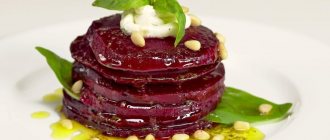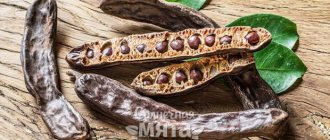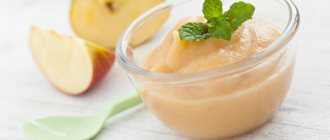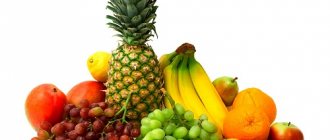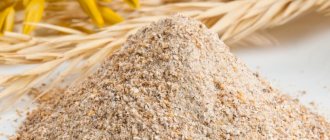Composition and calorie content of melon
The next interesting question is how many calories are in melon. The calorie content of melon per 100 grams is only 33 kcal. It contains 0.6 g of protein, 0.3 g of fat and 7.4 g of carbohydrates. It contains the following minerals:
- magnesium;
- potassium;
- calcium;
- zinc;
- manganese;
- copper;
- iron;
- iodine;
- fluorine;
- phosphorus;
- sodium.
The fruit also contains a significant amount of dietary fiber, which is typical for fruits and vegetables.
What vitamins are in melon
The benefits of melon for the body are largely due to the presence of vitamins in it. Despite the fact that most of the weight of the fruit is water, it is rich in vitamins A, group B, C, E, H, PP.
Application
Usually in the summer they like to dry melon either in the oven or in the sun. The fruit is usually cut into pieces, after which it is laid out on newspaper and placed in the sun. When 3-5 days have passed, a ready-made, tasty and sweet treat will appear on your table. But it is worth remembering that only summer varieties with dense pulp are suitable for drying. These can be varieties such as: Kolkhoznitsa, Bykovskaya, Zimovka, etc. Such varieties after drying have a rich taste and aroma.
Since melon has low calorie content, it is used in various diets. They use it even with strict diets. But you shouldn’t get carried away with it, since the amount of sugar in it is clearly high.
Dried melon is often used as a flavorful dessert for the table. Sometimes it is even used as a filling for baked goods. And of course, if you wish, you can cook delicious jelly or even compote from dried melon.
Market Analytics
- COVID-19 is changing the rules of the game in the cosmetics market
- Beauty of the future: cosmetic innovations 2020
- New ingredients are the driving force of the cosmetics industry
Convenient search for beauty salons on our website
Beauty salons in Moscow Beauty salons in St. Petersburg Beauty salons in Ekaterinburg Beauty salons in Novosibirsk
Latest blog posts on our website
- Naturecream / Geranium (Pelargonium) oil for skin health and beauty
- Prostye-sovety / Save on a beauty salon: procedures that can be done at home
- Naturecream / Growth Factor - brings back youth?
- Oksana-Lezina / 3 effective abdominal exercises from a fitness instructor for beginners
- Prostye-sovety / Making perfect curls at home
- Prostye-sovety / Which hair removal method to choose
- Naturecream / Wrinkles Puppets
- Naturecream / PEPHA-TIGHT - instant skin lifting
- Naturecream / Blue light - a danger to the skin
- Naturecream / Cocoa Butter – A treat for the skin
Latest forum topics on our website
- Mrs._Smith / Badly sunburned! What to do?((
- Ice / Is it necessary to combine fitness classes with a diet?
- Antonova / What can be used for hair loss?
- Radio operatorKat / Who was on a protein diet?
- Suzanna / Mesotherapy on the face
Other articles in this section
| Dried mango It is probably impossible to find a person who does not know about mangoes. This product tastes great and can be purchased at almost any store. |
| Brazil nut Brazil nut is one of the tallest trees in the Amazon rainforest. Its fruits are contained in oval boxes, which are quite impressive in weight - the weight can reach 2 kilograms, and the diameter is -15 centimeters. The homeland of Brazil nuts is South America. The fruits of the tree are collected only in wild forests. The main consumers of nuts are animals, birds and insects. |
| Uryuk There are many fruits, the consumption of which is necessary to replenish various vitamins and microelements in the human body. One such fruit is apricot. The countries of Central Asia are considered to be its homeland. This fruit, according to many scientists, doctors and nutritionists, is considered very useful not only in fresh, but also in dried form. There are three types of dried apricot fruits: dried apricots, kaisa and apricots. The first two types are dried fruits without seeds, and apricots - with seeds. Therefore, it is generally accepted that apricots are of great value, since they are dried in natural conditions on trees. These fruits are not picked until they lose all their liquid and that is why all the vitamins and minerals are preserved in these dried fruits. |
| Sunflower seeds Sunflower is a plant from the Asteraceae genus. This species has been cultivated for a very long time. Apparently this happened around 3000 BC. in the North America region. Archaeological research suggests that the first users of sunflowers were North American Indians. |
| Dried pears The pear is rightly called the queen among all fruits. It not only has excellent taste, but also properties that benefit human health. |
| Dried rose hips The history of using rose hips as a medicine goes back many centuries. It originally grew in the foothills of the Himalayas, but over time it spread throughout the world. Rose hips were first mentioned in Russia in chronicles of the 12th century. Its medicinal properties were so valued that the price of the fruits was close to that of expensive fabrics. At the same time, in Uzbekistan, rose hips for medicinal purposes were given only to noble people and only by special order. In medieval Europe, monasteries took their tithes from rose hips. |
| Apple chips Thin slices of apples that have undergone sublimation (vacuum drying) are commonly called apple chips. Dried apples can be considered their predecessor, but unlike them, apple chips can be stored much longer without loss of quality and have a pleasant crunch. |
| Candied pears Candied pears are fruits boiled in sugar syrup and then candied during the drying process. |
| Pine nuts Pine nuts are the seeds of Siberian pine. An evergreen coniferous tree, which bears fruit on average once every 5 years, produces about 12 kg of harvest. Pine nuts are small grains of pale yellow color. In terms of price, they are one of the most expensive. They are usually sold in purified form. Nuts are widespread in eastern and western Siberia. |
| Walnut Walnut belongs to the southern culture. A long-lived tree that begins to bear fruit at the age of 10 and is capable of producing up to 400 kg of fruit per year. Nuts are also called “acorns of the gods” or “food for the mind.” The fruit is a bivalve drupe, inside of which there is a four-layered seed. It grows in many countries - Ukraine, Central Asia, the Caucasus, China, Moldova, France. |
Useful properties of melon
Now let’s look at what health benefits the product has:
- The ability to saturate, provide energy, lift your spirits and improve your emotional state.
- Cleansing the skin, strengthening hair, blood vessel walls and nerve fibers - all thanks to silicon.
- Improving intestinal function and digestion of food in general due to the large amount of fiber.
- Normalization of energy processes in the body, which is provided by vitamins PP and folic acid.
- Improving the appearance of the skin, for which B vitamins are responsible.
- The mild diuretic effect that melon juice has.
- Strengthening the nervous system thanks to B vitamins, potassium and silicon.
- Beneficial effects on the heart and blood quality provided by vitamins B1 and B2.
- Immune system support with vitamins A and C.
It’s worth talking separately about the beneficial properties for men’s and women’s health.
What are the benefits of melon for men?
Men can use melon products to treat prostate diseases. The fruit also contains zinc, which improves sperm quality.
The benefits of melon for women
Folic acid in the composition alleviates the difficulties of pregnancy and menopause. Thanks to silicon, the condition of the skin improves: rashes and irritation disappear, wrinkles are smoothed out. A-antioxidants are also beneficial for the skin - they increase elasticity and prevent the appearance of stretch marks.
Melon for weight loss
The fruit is suitable as a component of the diet due to its low calorie content. The diuretic effect, which relieves swelling, as well as the ability to remove toxins will also be useful.
Important! Despite its low calorie content, melon contains carbohydrates, the daily amount of which is important to monitor when losing weight.
The fruit consists of 90% water, so it saturates well without overloading the body with extra calories.
Benefits of melon
The beneficial properties of melon are:
- Regular consumption of the product ensures the prevention of heart and vascular diseases;
- melon helps cope with depression and nervous disorders;
- due to its diuretic effect, melon is used to prevent diseases of the genitourinary system;
- It is recommended to include the product in the diet for hemorrhoids and constipation;
- melon is indicated for anemia, gout, malfunction of the kidneys and gall bladder;
- due to the large amount of vitamin C in melon, it is recommended to strengthen the immune system;
- melon eliminates irritability, normalizes sleep, stimulates brain function;
- Melon-based cosmetics are used to improve the condition of skin, hair, and nails.
Is it possible to eat melon during pregnancy?
This unique vegetable is beneficial for the body of the expectant mother and child due to the following properties:
- Increasing hemoglobin, which is responsible for transporting oxygen and supplying it to the fetus.
- Improves intestinal motility, which helps eliminate toxins and combat constipation.
- Removing fluid from the body, thereby reducing swelling.
However, it is not recommended to use the product in the 1st and 3rd trimester of pregnancy due to possible harm. Increased intestinal peristalsis can cause an increase in myometrial tone. Therefore, there is a possibility of miscarriage at short terms or premature birth in the 3rd trimester.
What are the benefits of dried melon?
Dried melon fruits serve both as a separate snack and as an addition to baked goods, salads, ice cream, and sandwiches. This is an excellent remedy for stressful situations and anxiety. It is known that the product is able to prolong youth and preserve beauty.
General benefit
Thanks to its unique composition, dried melon is capable of:
- provide internal protection of the body from the sun;
- normalize metabolic processes;
- cleanse the liver of harmful toxins;
- remove kidney stones;
- normalize gallbladder function;
- prevent the occurrence of vitamin deficiency;
- restore the body after a long illness;
- strengthen the heart muscle and improve heart function;
- remove excess water and remove swelling;
- resist viruses and infections;
- increase tone and improve mood;
- increase hemoglobin and prevent anemia;
- prevent dehydration and, as a result, eliminate nausea and cramps;
- calcium present in the composition will strengthen bone tissue, teeth, muscles;
- thanks to magnesium, a person’s mental state is normalized;
- phosphorus is essential for eyes, bones and teeth.
Did you know that the substances and pigments present in the composition affect tanning? Thanks to them, you can tan faster and more evenly and maintain the effect of the sun longer!
For women
Thanks to the content of folic acid, women during menstruation and menopause will be able to reduce ailments, pain and other unpleasant sensations.
Dried melon will strengthen blood vessels, muscles, and bones in the body, thereby rejuvenating it. It is known that it increases immunity, appetite and tone of a person, which is especially important for the weaker sex.
The treat will bring pleasure and relieve skin problems. It will not only eliminate annoying pimples and blackheads, but also completely cleanse the skin and smooth out wrinkles. Candied fruit is good for nails and hair. It strengthens them, gives them shine, helps them grow healthy and beautiful.
For men
It is known that the stronger sex is more susceptible to heart disease, so dried melon fruits will provide them with invaluable help. Regular consumption of the product will normalize heart function and prevent stroke or heart attack.
Dried melon plays an important role in increasing male strength and sexual desire. Thanks to him, a man becomes confident and active at any time of the day.
During pregnancy
Many things are prohibited for women during pregnancy, but melon is not included in the list of prohibited foods. Doctors sometimes even recommend including vegetables in your daily diet. Valuable micro and macroelements, vitamins and amino acids are useful not only for the mother herself, but also for the unborn baby.
The folic acid contained in dried candied fruit will help get rid of fatigue, relieve ailments and stress. It stabilizes hormonal levels or background, strengthens the immune system, and improves mood, which is especially important for a pregnant woman.
Despite all the benefits of dried fruits, it is not recommended to abuse them. We must not forget about the child, who can be harmed by excess.
Thanks to magnesium, sleep will improve, which will have a beneficial effect on the general condition of a woman. The dried delicacy will relieve cramps and normalize heart function.
When breastfeeding
A woman after childbirth especially needs nutritious food. She needs to recover herself and give her child the most beneficial things for development. It is important for a nursing mother to have enough milk in her breasts. Melon can provide all this, since its fruit contains almost 90% water and many nutrients and vitamins important for the body.
Thanks to the fiber contained in the dried treat, the functioning of the gastrointestinal tract is normalized, the number of lactic acid beneficial bacteria increases, and weight is normalized.
Through mother's milk, the baby will receive all the necessary substances for growth and development. His immune, nervous and circulatory systems will be properly formed, his mood will improve and his sleep will normalize. Thanks to vitamin C and iron, hemoglobin will increase and resistance to infections and pathogenic bacteria will increase.
Despite all the advantages, you should use the product very carefully during lactation! First, it is important to check how the child reacts to the product, and if he is not allergic to the dried treat, then it can be safely included in his daily diet.
Regular consumption of dried melon will help a woman restore the elasticity and balance of the skin in a short time.
For children
Children are allowed to give melon from 9 months of age if they are not allergic to it. You need to start with small test doses - drop by drop. The dosage should be increased gradually so that the body gets used to it. The dry product can be given to a child from 4 years of age.
Melon is easily digestible and does not cause problems with its digestion. It has a positive effect on the functioning of all organs and systems, and also promotes the growth and development of the baby, as it has many beneficial properties.
When losing weight
The dried delicacy is irreplaceable for weight loss. This sweet product will not only not disrupt your diet, but will also replenish the body with missing elements and water. Moreover, they will not affect your weight in any way.
It is known that Thai (cantaloupe) melon contains sugar several times less than other varieties, so it will be an ideal solution for the diet.
There is practically no fat in melon, but there is fiber, water and sugar. Candied fruit will satisfy hunger, and thanks to fiber, the intestines will be effectively cleansed. Eating dried melon during a diet will not allow your body to weaken and will lift your spirits.
Melon during breastfeeding
A nursing mother can eat melon, observing certain conditions:
- The first portion should be eaten in the morning and in small quantities to check the child’s reaction.
- The fruit should be eaten separately from other foods, as a separate meal.
- It is important not to overeat - even the most harmless food in large quantities can be harmful.
- It is advisable to eat melon during its ripening season. You should avoid eating imported fruits, and instead receive the benefits of candied melon.
The body of every woman and child is individual, so in any specific case it is important to take into account the doctor’s recommendations.
Is melon harmful for pancreatitis?
With this disease, eating fruit is not allowed, and there are several reasons for this:
- The product increases the amount of gastric juice, which harms the pancreas.
- Fiber and sugars cause a fermentation process, which causes profuse stool, gas formation and discomfort.
- Carbohydrates, of which the fetus mainly consists, load the endocrine structures of the pancreas.
During the remission stage, the product can be eaten in the form of jelly or mousse. If there are no negative effects, then small pieces of the fruit can be consumed fresh, but not earlier than a week after the exacerbation.
Description of culture
Melon is an annual herbaceous plant belonging to the genus Cucumber of the Cucurbitaceae family. When growing on their own, gardeners are advised to choose crop varieties bred specifically for their region, because heat-loving species cannot develop well at low temperatures and high humidity. The fruits are pumpkins, which are characterized by yellow, orange, greenish, brown or white coloring with greenish stripes. The shape of the berries can be round or oval.
The sweet and juicy pulp is usually consumed fresh . Melon has many uses in cooking: it is dried, baked, and used to make marshmallows, candied fruits, jam, desserts, and fruit salads. The seeds and fruits of the plant contain many vitamins and beneficial elements. They help in healing various ailments and heal the human body. But experts do not advise using this product frequently, because it can also have a negative effect on health.
Melon was even used in developing the “Armenian” cucumber variety, which is also called “silver melon.” An exotic crop of unusual appearance has a sweet taste and a pleasant melon aroma. This interesting vegetable has already become a frequent guest on the dinner table of many summer residents.
Beneficial properties of melon juice
Melon juice is a healthy and nutritious drink that quenches thirst well and has a positive effect on the body:
- improves kidney function;
- cleanses the body of chemotherapy products;
- has a diuretic effect;
- relieves joint pain.
Juice is especially useful for older people. The components in its composition prevent the deterioration of memory and concentration and rejuvenate the body. The juice is prepared not only from the pulp of the fruit, but also from its peel - this drink has an anti-stress effect thanks to essential oils.
Melon seeds: benefits and recipes of traditional medicine
The benefits of melon seeds are explained by the large amount of potassium, sodium and magnesium. They also contain B vitamins, which promote tissue repair. The seeds also have other beneficial properties:
- remove heavy metals and pesticides from the body;
- normalize cholesterol levels;
- improve potency;
- prevent prostate adenoma;
- enhance the effect of medications;
- have a positive effect on metabolism.
These positive characteristics make the seeds of the fruit an effective traditional medicine.
Against cholecystitis
To treat this disease, an infusion of seeds is prepared. 1 tsp. seeds, crushed into powder, are poured with boiled milk and boiled for an additional 4 minutes. You need to take the product 2 times a day.
Against urolithiasis
To remove kidney stones, 1 kg of seeds must be boiled in 5 liters of water. When about 3 liters of water remain in the pan, the broth should be cooled, bottled and refrigerated. The product should be drunk half a glass three times a day before meals.
Application in cosmetology
Masks based on fruit pulp rejuvenate and moisturize the skin, soothe irritation, and also make hair beautiful and healthy.
Face masks
To nourish the skin 2 tbsp. l. pureed pulp should be mixed with 1 tsp. honey and apply to facial skin. Keep the mask on for about 30 minutes.
To get rid of irritation, you need to mix a mashed piece of fruit pulp with 1 tbsp. l. cream cheese and 1 tsp. pumpkin oil The product is kept on the face for 15 minutes and removed with a cotton pad soaked in milk.
Melon for hair
To soften and moisturize your hair, you need to mix a few pieces of melon, 100 g of cognac and 150 g of strong black coffee. Apply the mask to clean and slightly damp hair, rubbing it into the roots. You can wash off the product after 40 minutes.
To strengthen your hair, you can make a mask based on melon juice, butter and sour cream. Mix half a glass of juice with 1 tbsp. l. olive oil and 1 tbsp. l. sour cream. The product is applied to the hair and left for 40 minutes.
Drying melon at home
Drying fruits yourself is not difficult. Fresh and healthy fruits are suitable for winter preparation. Thai melon is perfect.
In the oven
- Wash the fruit and dry it.
- Cut in half and remove the entrails.
- Remove the peel.
- Cut into cubes or slices.
- After the pieces are prepared for drying, you need to take out a baking sheet, cover it with baking paper and lightly grease it with oil (vegetable oil). Turn on the oven and heat to 120C.
- You can place the melon pieces on a baking sheet and put them in the oven. After 20 minutes, the temperature should be reduced to 75-80C.
- Cooking time depends on the wishes of the hostess. If you want to get slightly dried sweets, then 1.5 hours is enough, if you need “resistant” dried fruits, then 2 or more hours will be required.
- After taking the pieces out of the “oven” they are cooled. During the drying process, turn and stir regularly to ensure uniform heat treatment and to prevent sticking.
In an electric dryer
- Prepare pieces or slices for drying, no more than 1 cm thick.
- Place the dryer on preheat for 5 minutes, covering it with a lid.
- Place the fruit preparations on trays and place them in the oven.
- Temperature – 70C. The process time is at least 8 hours.
- Periodically swap the trays with fruit so that the process goes evenly.
- The electric dryer needs to be given time to “rest”, so it should be turned off for 15 minutes to avoid burnout of the equipment.
https://youtu.be/4mP2IE14dAw
Outdoors
- Wash the fruit and cut it lengthwise.
- Remove the middle and peel the peel.
- Cut pieces no more than 4 cm thick and place them on a rope prepared in advance. You can use wire.
- If the process takes place in an apartment, then it is necessary to ensure ventilation and access to fresh air.
- The drying process takes almost 2 weeks.
- The slices need to be checked regularly and turned if necessary.
- Prepared candied fruits can be braided, wrapped in cellophane or film and sent for storage.
Use of melon in cooking
Most often, the product is eaten fresh, as an independent dish. In addition, you can make preserves, jam, and marmalade from melon. Compote is also made from the pulp of the fruit, and candied fruits are prepared from the peel. Melon marmalade is also delicious.
Attention! Eating melon with fermented milk products and alcohol is extremely undesirable - this will cause unpleasant consequences for the stomach and intestines.
It is not recommended to eat the product on an empty stomach, but it is not advisable to consume the treat immediately after eating. It is better to eat fruit a couple of hours after meals and some time before the next meal.
Possible harm of dried melon
Dried melon product can be not only beneficial, but also harmful. It can have a negative impact on human health if some of the substances it contains are not suitable for the body. For example, melon contains a lot of saccharides, so diabetics are not recommended to take it.
We list the main points in which you need to be careful when consuming dried delicacy, or completely exclude it from your diet:
- for diabetes mellitus;
- for any forms of gastrointestinal diseases and stomach disorders;
- exacerbation of pancreatitis;
- with overweight and obesity;
- for allergies.
You need to be careful when combining certain types of drinks and foods so as not to cause diarrhea and avoid unpleasant consequences. For example, it is not advisable to combine dried fruits with milk, alcohol, honey or water.
If you do not follow the rules, you can greatly harm your body. The resulting diarrhea will certainly entail a host of other negative and unforeseen consequences, such as dehydration or dysbiosis. And this is quite unpleasant!
How to choose a melon
To choose a tasty and healthy fruit, it is important to consider the following recommendations:
- There should be no dents or stains on the peel.
- The aroma of the ripe fruit is pleasant and sweet, and does not smell like grass.
- If possible, it is advisable to look at the color of the pulp - the richer it is, the riper and healthier the fruit.
- A high-quality fruit produces a dull, dense sound if its surface is lightly patted.
- The stalk and its attachment point must be dry.
The peel of the fruit on the opposite side from the stalk should be easy to press. This suggests that the melon was ripened in the melon field, and was not picked while still green. It is best to buy the product in August-September in trusted places.
How to dry melon
Cooking dried melon yourself will be much healthier and more economical. In stores, such a product costs a lot of money.
First you need to prepare it. You need to know that not all varieties may be suitable for drying and storage.
Which melon is best to take for drying?
The peculiarity of fresh melon is that it cannot be stored for a long time. In addition, not all varieties may be suitable for drying and the drying process. You need to choose a fruit with firm flesh. These varieties include:
- Gulyabi;
- Torpedo;
- Collective farmer;
- Pineapple.
Only undamaged fruits are selected for harvesting for future use. It is better to take the size medium. There are many varieties of melons that differ not only in shape, but also in content. Some melons are too juicy and are unlikely to be suitable for drying. It is better to choose a variety of medium juiciness so that the drying time does not take too long. After all, it is known that melon is 90% water. And when drying the product, it is necessary to evaporate all the moisture from the slices. The usual process takes no more than 12 hours, and it is necessary that not a single gram of water remains in the melon pieces.
How to dry
To get dried melon pieces at home, you need to cut the fruit lengthwise, leaving a bridge on top. This is done so that two slices can be placed on a rope or wire from different sides. The thickness of the cut pieces should be no more than 4 cm. Place the prepared slices on a prepared pre-tensioned rope. Drying should be carried out outdoors, so if the process takes place in an apartment, it is advisable to provide a sufficient amount of air.
Drying time is about 2 weeks. The slices must be checked and turned daily so that the moisture evaporates evenly.
You need to know that when dried, the weight of the slices decreases by 10 times relative to their fresh state.
After the product is ready, it can be removed, woven into one braid, well wrapped in film and left to be stored in a secluded place.
Drying in an electric dryer
Not everyone has electric dryers, but this household appliance is universal and can be useful for preparing any vegetables and fruits for future use. There is no need to select some super model. The simplest technique is suitable for blanks.
Rinse the melon fruit well, wipe it dry with a towel and cut into two halves. Remove the seeds, discard the peel and prepare only the sweet part of the melon for drying. The unsweetened part will be tasteless.
The next stage is preparing the dryer. Turn it on to warm up for five minutes and cover with a lid. Remove the trays and, while the unit is heating, cut the melon into thin slices. The thickness of the slices should not be more than 1 cm (even 0.5 cm is better). The pieces should also not be long so that they can fit on the pallet.
When the device heats up, lay out the prepared pieces. They should not touch each other; some distance must be left between them. It is important to receive warm air not only from below and from above, it is necessary that the slices are blown from the sides. The drying temperature is set to 70 degrees. It must be dried for at least 10 hours. The time will depend on the type of melon and its juiciness.
Pallets must be periodically swapped to ensure uniform evaporation of moisture. The equipment will also need rest, so it is worth turning it off for 10 minutes so that it does not burn out.
Oven drying
There is an oven in every home, so drying in this way will not require additional costs. This is a classic method of preparing the product that our mothers and grandmothers used. Cooked dried melon from the oven will be no different from the product from an electric dryer. Even in terms of cooking time, it will be faster, since you won’t have to let the stove rest.
The preparation of the fruit is the same as when drying in a machine: rinse well, dry, remove seeds and peel. Cut the slices into thin layers and place on a baking sheet. Preheat the oven to 70 degrees. Line a baking sheet with parchment paper.
Remember that melon contains a lot of liquid, so the slices will begin to release a large amount of moisture when dried. For this reason, there are two options to solve the problem:
- Leave the oven door open so that the moisture can evaporate without problems.
- Constantly change the parchment (every 3 hours) so that the slices are not submerged in water.
Used parchment paper can be dried immediately on an additional rack or baking sheet and used again.
The process will take the same 10 hours. You cannot leave the oven unattended during this time! Check and monitor the drying process regularly.
Video:
how to dry melon or watermelons Expand
Melon harm and contraindications
In addition to the benefits, the product can also cause harm to the body:
- A large amount of the product burdens digestion, causing stomach upset.
- The fruit can cause fermentation, which leads to flatulence and bloating.
- The product is contraindicated in patients with infectious diseases of the gastrointestinal tract.
- Excessive consumption of the fruit can cause hypervitaminosis, which harms the intestines and heart.
Overall, this tasty fruit is more beneficial than harmful. The main thing is to observe the measure and take into account possible contraindications.


